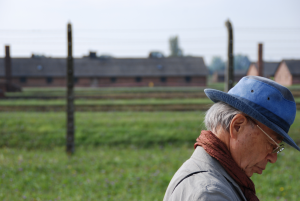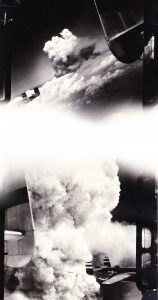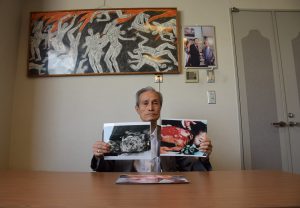
Takeshi Miyata wanders through Auschwitz during his 85 journey around the world on Peace Boat’s 80th Voyage.
“Everything is connected,” exclaimed Takeshi Miyata as he walked along the railway at the Auschwitz death camps, almost 70 years after Jews were carted off to slaughter in the same location. “Jewish scientists escaped the Nazis, helped America build an atomic bomb, and it was dropped on me.”
Anyone who entered Hiroshima and Nagasaki within two weeks of the release of the only two atom bombs detonated over people were designated as Hibakusha: “Exposed to the atomic bomb/radiation.” Miyata, and eight other members of the Peace Boat Hibakusha Project, had traveled halfway around the world from Japan. They shared their cautionary tales of nuclear power in each port of call along the way. Some spoke publicly for the first time in their lives. I was their web reporter.
Peace Boat, part cruise ship, part political lobby, was on its 80th voyage in 30 years. The Hibakusha Project was participating in a Peace Boat voyage for the sixth time. Our journey in 2013 started in Da Nang, Vietnam, where we spent the day with victims of Agent Orange who have experienced generational effects of the chemicals wartime use. We confronted Japan’s own violent past in Singapore at the National History Museum. We shared testimony with a Hungarian-Polish Auschwitz survivor at the center for Dialogue in Poland, and befriended El Salvadorian revolutionaries in Central America.
Over 85 days, we spoke at city halls, foreign ministries, schools, and temples in more than 19 countries. Thousands of people will now forever be able to say that they met someone who survived the bombings of Hiroshima or Nagasaki, and heard their testimony.

Mushroom cloud over Nagasaki from a passing airplane (photo courtesy of Orval Eli Labig).
Passengers on the ship called us the Orizuru Project. In Japanese “Orizuru” means “Paper Crane.” They say in Japan if you fold one thousand paper cranes you receive a wish. In 1955, Sadako Sasaki tried everything, including the legend, to cure her leukemia ten years after she was exposed to the atomic bomb in Hiroshima. She wasn’t the only one. Every family that survived Hiroshima had a Sadako, an unknown victim who was not made famous for their grace under pressure. A monument to memorialize all of the child victims was erected by Sadako’s classmates, and years later her story was told around the world. It’s how I learned about it in school when I was her age.
Miyata-san wasn’t the only one who could see connections. I wasn’t just a web reporter documenting Peace Boat’s Hibakusha Project. My grandfather was Jacob Beser, the only man in the world to fly as a serviceman on both planes that dropped the atomic bombs on Hiroshima and Nagasaki. He was the radar countermeasures officer. In essence, he helped build and monitor the radar-detonated fuse for the so called “gimmick.”
Many people know that my grandfather was on the airplanes, but few know that my family also has a connection to someone who was underneath the mushroom cloud.
I wrote about this coincidental connection in 2010, and mentioned Maiden J. publicly (and I will not use her name again). Her surviving family is very protective of her legacy. They were burned by Japanese media in the past who wanted to dramatize her love story. Her family was upset I started to write about her, until they realized they knew me.
She left Hiroshima in the late 60s to marry an American who courted her while she lived in New York where she received reconstructive surgery with the famous Hiroshima Maidens. She eventually settled in Baltimore where she worked alongside my future grandfather Aaron Cohen. I met her when I was a child and was awestruck about knowing people from both sides of the bomb.
On March 10, 2011, I won a research grant to write a book about my family connections. It was already March 11 in Japan, a night when distaster struck. As the news unfolded of what would become the Great East Japan Earthquake, Tsunami and Nuclear Disaster, I decided not to give up my trip to Japan.
Five months later, I began the research for a book that took me five years to complete. “The Nuclear Family” available on Amazon now, and Kindle August 10. When I met Maiden J.’s family, they said, “We can be your friends, but if you want to understand what happened you must meet Hibakusha who will tell you first hand.”
A reporter from Japan’s Asahi Shimbun introduced me to film director and visual artist Shinpei Takeda. Intrigued by my story, Takeda felt a duty to explain the Japanese side to my young American self. He thought of no better person to introduce me to than Yuji Sasaki. Yuji is the nephew of Sadako. At the time, he owned a Ramen shop called Danke in Nakano. He recently sold it to fully dedicate his energy to “Sadako Legacy,” his family’s nonprofit. When I met him for the first time, Danke was serving up hot delicious bowls of Hakata Ramen.

Suimteru Taniguchi holds up two photos of himself taken in the aftermath of the atomic bombing of Nagasaki.
Within minutes of our group’s arrival, Yuji leapt to the back of his shop to look for a small plastic box. He returned momentarily and opened it to reveal a pin-size paper crane and a small folded triangle of paper. He placed the tiny crane in the palm of my hand and said, “This is the last crane she ever folded, and this triangle is the crane she didn’t finish.”
“In 2010, my family decided to donate a paper crane to the 9/11 memorial in New York City,” proclaimed Yuji. “When we did, we met the grandson of President Truman, Clifton Daniel. I placed in his hand the last crane, like I’ve just done for you and asked him what I’m about to ask you. ‘Will you work with us to send a message of peace?‘”
Yuji is changing the world with his aunt’s paper cranes. He and his father Masahiro have donated Sadako’s cranes to the Hiroshima Peace Memorial, the 9/11 memorial, and the Arizona Memorial at Pearl Harbor, where Masahiro met a Pearl Harbor survivor who proclaimed, “They said you can’t teach an old dog new tricks,” before the Japanese and American survivors embraced in a hug. This Fall Sadako Legacy will donate a crane to the Truman Presidential Library before speaking at a convention for history teachers in New Orleans.
A week after meeting Yuji, and two years before my journey with Peace Boat, Shinpei also connected me to a disaster relief group at work in the tsunami-devastated region of Tohoku, in a city called Ofunato. While there I met a young woman named Erica. Erica asked me, “What brought you to Japan?” I told her my family story, but to my surprise she had one too. “My grandfather was on one of the weather planes over Nagasaki. My family even has photos he took of the mushroom cloud.
Last year, I reached out to Erica and she sent me her grandfather’s photos.
Throughout the Fulbright-National Geographic Digital Storytelling Fellowship, I explored these connections I discovered over the last five years, and found new members of “The Nuclear Family” as well. Follow Hibakusha: The Nuclear Family on Facebook. There are already articles, photos and now videos as well.


No Comments